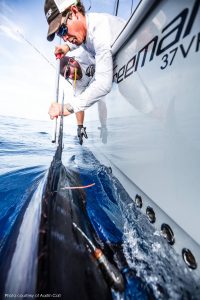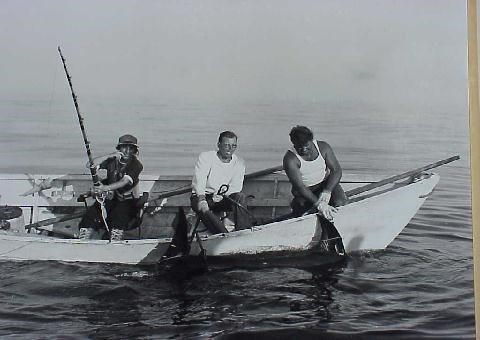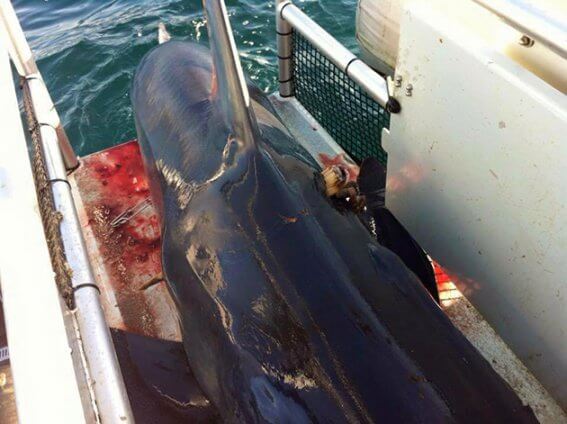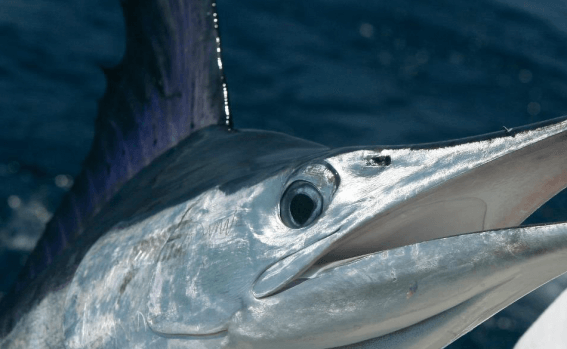Welcome to our Did You Know blog! Billfish and related species, like tuna and swordfish, are amazing creatures and set themselves apart from other fish. The Billfish Foundation would like to share some of the most interesting facts and stories involving these fish. What are some of the things that surprised you about these magnificent animals? #didyouknow
October 23, 2019 – Satellite Tagging

Did you know that traditional tagging is not the only kind of tagging that TBF does? If you have followed us for a while, you may have heard us talk about satellite tagging, but what exactly is it, and how is it different from normal tag and release? Traditional tagging occurs when an angler hooks a billfish, brings it alongside the boat, inserts a spaghetti tag into its dorsal flank, and releases it safely back to the water. The spaghetti tag contains a number, which identifies the fish when it is recaptured. This action, which takes only a few minutes, enables TBF to track things like billfish density, local species composition, growth rates, migration patterns, post-release survival rates, and more!
So what is the difference between traditional and satellite tagging? While the process of tagging is approximately the same, the data that is received from satellite tags is not. In addition to the information gained from traditional tagging, satellite tags transmit information in real time and measure various aspects of the ocean, including pressure, light, and temperature. These oceanographic recordings enable scientists to determine the approximate depth and location of the tagged fish after release. This provides TBF and scientists with more finite information regarding the way that billfish migrate and where in the water column they spend most of their time. We can then to identify things like foraging times and locations as well as spawning sites. Knowledge of these areas that are so vital in the life history of billfish enables us to work to secure increased protections for them, such as limiting the amount or type of commercial fishing that can occur there or turning them into marine protected areas.
Satellite tags can tell researchers the time of day and in what vertical area of the water column billfish tend to feed. In fact, a study done by researchers at the University of Miami, in conjunction with TBF, did just that! By deploying satellite tags on blue marlin, researchers were able to create models that showed depth use by marlin throughout the day. This information is incredibly helpful in letting commercial longliners know what time of day, and at what depths, they should deploy their longlines in order to minimize their chances of catching billfish accidentally. Billfish bycatch is a major cause of billfish mortality across the globe and negatively impacts the commercial fishery, as every billfish caught is equal to a target species not caught. In this way, conservation science can work with the fishing industry in order to minimize waste, be that fishing effort and supplies or billfish lives!
Want to know more about satellite tagging? See our research repository under the Publications portion of our website to read about more scientific breakthroughs that have been made because of our tagging program!
April 21, 2019 – Forage Fish Abundance Importance for Billfish

Did you know that billfish have a wide variety of diet throughout their life cycle? This is partially due to the drastic change in size throughout their life cycle. Newborn billfish are about the size of a thumbnail and, in some species, will grow to upwards of 1500 pounds! Due to their drastic change in size, billfish forage preferences change at different stages of their life.
At their small juvenile size, billfish will start out consuming micronutrients such as zooplankton. As they grow bigger, billfish move on to bigger prey such as squid, hardtails, flying fish, and other small pelagics. From this stage forward, squid stay a favorite forage of billfish.
When bigger billfish reach around 300lbs, their most popular forage are smaller tunas like yellowfin, skipjack, bonita, and blackfin. However, dorado, rainbow runners, mackerels, larger hardtails, and squid all are forage options for these fish as well. In general, they prefer medium size prey between 5 and 10lbs.
As they continue to grow, their species billfish forage stays the same, but they will consume larger versions. In addition to the larger tunas, dorados, and mackerels, they will begin preying on smaller billfish such as spearfish. For example, many boats in Australia pull large, 50lb mackerel to entice giant black marlin to bite. However, 1000lb marlin are caught every year in Kona, Hawaii on much smaller artificial lures. This shows that larger marlin will go after both large prey and smaller offerings alike. For anglers, there are two strategies to manage this. First is to match the hatch of what is being seeing on the water. Second is to have a variety of baits in different sizes to present to the different targeted fish.
Understanding these unique predator/prey relationships is important when discussing fisheries management policies. Currently, the primary fishery management law of the U.S., the Magnuson-Stevens Act, does not include provisions for managing prey or forage fish that provide an important food source for larger fish, marine mammals and birds. If the Forage Fish Conservation Act (FFCA), a bipartisan bill introduced on April 10, 2019, becomes law, monitoring and assessments will be required of predator needs, impacts of increased removal of forage fish on other species, and established fisheries and fishing communities before any new or increase is harvest could be approved. It is imperative that our policies take these relationships into account since forage fish (like ballyhoo, menhaden, tunas, dorado, and mackerels) are tied so closely to predatory species like sharks, marine mammals, and billfish.
November 28, 2018 – The Importance of Properly Reporting and Recaptures
 Did you know that accurate reporting of tagged billfish leads to better recapture data and better overall data? Tagging is an important practice that many boats exercise, but what is just as important is the reporting side.
Did you know that accurate reporting of tagged billfish leads to better recapture data and better overall data? Tagging is an important practice that many boats exercise, but what is just as important is the reporting side.
Tagging billfish is important for the conservation of billfish and the billfishing sport. It provides information on billfish life cycle, movement, growth, and post-release mortality. Here at The Billfish Foundation, we take pride in the tagging database that we have built over the years. One of the most important things for us is proper reporting of both the initial tag and the recapture. In fact, one of the biggest hindrances in our database is missing information on tag cards we receive from anglers.
The most common information that is missing on tag cards is the weight or length of a fish. While length can be tough to measure in the water, an estimated weight is not too difficult, and is invaluable. Without these measurements, we have no idea how much a recaptured billfish grew in the time between catches. Accuracy is also crucial in size measurements. For example, getting a recaptured billfish report that says the fish weighed roughly 250lbs when the initial tag report says the fish weighed 400lbs three years prior doesn’t help contribute to the knowledge of the biology of the fish.
Another important piece of information in tag and recapture data is the location of where the fish was caught. Not having an accurate location (with a latitude and longitude) at both the tagging and recapturing point in the process hinders knowledge that can be learned about the movement of the fish. This can lead to bad management in the future and a lack of understanding of billfish migration.
To promote the tagging process and better reporting, The Billfish Foundation hosts an annual tagging competition worldwide that awards captains and anglers for tagging and releasing the most billfish every year. The competition is split up into multiple categories, including species and ocean, to include all of our fishermen worldwide. It is our way of acknowledging the important work that these anglers do for billfish and the sportfishing community.
It is vital that anglers, captains, and crews fill out tag cards accurately. The purpose of the tagging program is to get accurate data to better understand and manage billfish. Bad data hurts the reputation of our community and greatly affects what conclusions we make about billfish science. This also hurts the tagging competition, which works to compile accurate data and award individuals and crews that contribute most. Thus, please only report accurate data.
Tagging does a lot to help improve our knowledge about billfish and more accurate reporting could vastly improve this process. If sending in cards is hard, The Billfish Foundation has a new app to make reporting catches easier.
November 14, 2018 – How Deep Can Marlin Dive?

Did you know that blue marlin can dive to incredibly deep depths in the ocean? Blue marlin are one of the top ocean predators and gamefish around the world. Blue marlin are sought after for their fighting skills, acrobatic displays, and the difficulty associated with catching them. Generally, fishing techniques for blue marlin consist of trolling artificial lures, dead baits, or live baits on the surface. Some boats pull live baits on a downrigger during hot days, but most techniques are surface fishing applications. Additionally, hooked blue marlin typically choose to stay on the surface grey hounding and tail-walking during a fight. Despite this, blue marlin actually have the capability to dive to deep depths.
Blue marlin can swim down to depths beyond 2,000 feet deep! This was discovered by Dr. Phillip Goodyear, a scientist who works in conjunction with The Billfish Foundation. In Dr. Goodyear’s study, 51 blue marlin were tagged with satellite data archival pop-up tags. These tags stay with the marlin and record measurements such temperature, depth, and distance traveled. They then pop off the marlin and, upon reaching the surface, transmit the data to a satellite. These satellite tags showed blue marlin routinely diving to depths of 400-600 meters (1300~1900 feet), with some fish diving to depths deeper than 800 meters (~2600+ feet) during the day time! There are multiple theories to why blue marlin dive this deep. One is they do it to feed on prey at different depths in the water column, namely for squid. Interestingly enough, though, billfish do not perform these deep dives regularly at night.

This work shows how important the use of satellite tags are in billfish research. Despite being effective in other research areas, we never would have learned information like this from conventional tags. This is why satellite tagging expeditions are invaluable in furthering billfish conservation worldwide.
October 30, 2018 – The Evolution of Fishing Gear

Did you know that recreational fishing tackle for billfish has changed drastically over the past 50 years? The list of advancements is quite extensive, but below are some of the biggest changes!
Fishing line has advanced quite a lot over the years. In particular, fishing line has become much stronger in terms of breaking strength and knot strength. Before World War II, all fishing line was made of natural materials, like linen. Today, it is made of manufactured materials. Due to this change in material, current fishing line can often exceed the limit for which it is rated. For example, some manufactured lines at 100lbs test have a breaking strength above 130 pounds!
Fishing rods have also evolved significantly over the years. When targeting a large, strong fish like marlin, anglers were previously forced to use very large, heavy rods. Fortunately for today’s anglers, fishing rods have become stronger in much smaller models. Therefore, a boat does not have to be set up to use large heavy tackle when targeting billfish. This allows boats of all sizes to target billfish, as opposed to just sportfishers!
Another major advancement in fishing gear is the evolution in sonar and fish finders. Previously, the only technology available was a machine to track the bottom and the water temperature to detect current breaks. Boats today have sonars that mark billfish and bait vertically in the water column and even scan the sides. Thus, boats can mark bait and billfish in a much larger area than ever before. Some boats can use this technology to mark billfish a mile away, allowing them a huge advantage in catching fish!

These are just some of the major changes to fishing gear that have taken place over the past 50 years. The main outcome of these changes is an increase in billfish catch rates. As long as good conservation efforts are in place, this will not have a negative impact on billfish population numbers. Thus, billfish conservation is important to make sure these and future advancements only have positive effects.
October 16, 2018 – Billfish Dimorphism

Did you know that billfish exhibit sexual dimorphism? Sexual dimorphism is when males and females of the same species have different characteristics other than their reproductive organs. These characteristics can be things such as size, colors, and body appearance traits.
For example, lions exhibit sexual dimorphism. Male lions have a large mane around their head that females do not. In another example, male mallard ducks have a green head and white back, whereas females stay brown. Billfish exhibit sexual dimorphism in that female billfish grow bigger than male billfish. Typically, male blue marlin do not reach weights above 150kg (330lbs). However, females are able to reach weights above 910kg or over 2000 pounds (ICCAT)! A study of black marlin near Taiwan found females reached 302kg (660lbs), whereas the heaviest of males they sampled reached 85kg (185lbs) (Institute of Oceanography, National Taiwan University).
So why do females grow so much bigger than males? The main reason is for reproduction. The larger the female is, the more eggs she can release to be fertilized by males in the water. This allows for potentially more juveniles to be born in each breeding occurrence. Additionally, as females grow, their number of predators shrink, which allows them to more safely transport their eggs. In scientific terms, as a female’s size increases, her fecundity (reproductive success and increase in reproduction rate) also increases. Contrary to popular opinion, all of the larger billfish are actually females rather than males. So, in Hemingway’s tale, “The Old Man and the Sea”, the great marlin that Santiago does battle with was a female; despite the fact that Santiago called the marlin ‘he’ throughout the story.
October 2, 2018 – A Crazy Fish Story
In 2002, a nearly divorced angler placed his wedding band on the bill of a sailfish he caught near Fort Lauderdale. After some new bling and a quick picture, the fish was released. After nearly three years had passed and his divorce finalized, the man decided to go fishing again. To his surprise, the man reeled in the same sailfish, still sporting his wedding ring around its bill! The fish’s bill grew around the ring as depicted below. The fish’s ability to survive so long means the angler caught and handled it correctly the first time.

No word if the angler reunited with his ex following this amazing recapture, but he definitely won’t be getting his ring back!
September 18, 2018 – What is the longest distance traveled by a billfish that was tagged and recaptured?
Did you know the longest marlin migration recorded by The Billfish Foundation was a blue marlin, which swam 6,614.1 miles? Billfish are Highly Migratory Species, which will follow warm ocean currents for hundreds to thousands of miles. The Billfish Foundation works to study the migration as well as understand growth rates, migratory habitat utilization, and post-release survival rates of these amazing fish through our Tag and Release program. A prime example of this program and its awesome results is that of a blue marlin which was initially caught and tagged by Captain Charles Cabell and angler Lisa Hawkins on June 29, 1991, off the Oregon Inlet in North Carolina and recaptured by Captain Dietmann Kossman, on February 5, 1993, in Angola, Africa. That’s a migration spanning 587 days, which mean the fish traveled roughly 11 miles a day.

The second longest migration tracked of a tagged billfish was that of another blue marlin which was caught by Captain Bobby Brown in 1997 in St. Thomas, U.S. Virgin Islands and was later recaptured June 2000 in the Gulf of Guinea. That means the fish traveled 4,197.8 miles over the span of almost three years!
August 31, 2018 – What about billfish anatomy makes them so fast?
Did you know that marlin have interlocking vertebrae, making their body compositions stronger than most fish? Most fish have multiple small vertebrae whereas billfish have large vertebrae. Marlin and sailfish have 24 vertebrae, while swordfish have 26. This skeletal structure allows these fish to have a high degree of lateral (side-to-side) flexion. This skeletal flexion combines with their muscular power to enable them to have diverse, dynamic movement. This is why billfish can travel so far, reach such high speeds, and leap so high out of the water.

The spine of a billfish is made up of large vertebrae. Each vertebra has a large, flat plate that extends across the intervertebral joint into the next vertebra, where it interlocks. This provides spinal stability and help protects against injury. Similar to human spines, swordfish have collagen between each vertebrae for cushion and elasticity.

The versatility and extensive makeup of billfish spinal cords gives these fish a kind of elastic energy and the ability to be flexible, enabling their diverse movement abilities and fast speeds. These fish unique body composition makes them fast and relentless predators and also fun to catch recreationally. It also makes their migration patterns interesting to tract. To see the awesome abilities these fish’s bodies have be sure to check out the TBF Tag Database to follow the movements of past tagged marlin!
July 25, 2017- Hunting Tool or Weapon?
Did you know that a single blue marlin cost British Petroleum (BP) $100 million in damages? A marlin’s impressive size, speed, and strength make them one of the most desired fish to catch. However, when combined with their strong, sharp bill, these same features make them a dangerous weapon. In 2010, a blue marlin punctured a highly protected, ultra thick pipeline leading to BP’s Plutonio field storage barge. This one puncture prevented 900,000 barrels of oil from being exported for sale, equaling over $100 million in losses. Thankfully, very little oil was leaked into the water. Here are some more strange, gruesome, and unexpected instances where billfish (and swordfish) got wild with their bill:

A commercial fishing trip off the coast off Bermagui, Australia caught a large mako shark (below). After close inspection, the crew noticed that the shark had an object protruding from both sides of its body. Evidently, the bill of a large marlin had penetrated through the shark just under the dorsal fin and broken off. The bill had started growing barnacles, signifying that the shark had been carrying the burden for quite some time. Research shows that billfish primarily utilize their bills to kill or stun smaller prey, not to attack larger animals. Instances like these, however, prove that these fish aren’t scared to go on the offensive.

Some of the craziest documented attacks have been carried out by swordfish in the deep. In the first picture, a camera catches the instant a small swordfish penetrates a deep diver’s welding gear just above their oxygen tank – Click here to watch the full video. The footage clearly shows the swordfish singling out the diver and charging sword-first.
The second photo shows a swordfish lodged into the hull of Alvin, a deep sea Navy submarine. The Alvin is famous for voyage missions to survey hydrothermal vents, decommissioning sunken WWII bombs, and exploring the wreck of the Titanic. According to the Smithsonian, in 1967, Alvin was exploring deep sea corals in 2000 feet of water off the coast of Florida when a swordfish attacked and got stuck to its hull. The swordfish was just under 200 pounds and hit the sub so hard that the majority of its head was jammed into a small gap in the sub’s exterior, causing it to be brought to the surface.


More common instances of billfish impalement are those associated with fishing. There have been many instances of billfish impaling boat hulls and transoms, and sometimes anglers themselves. In 2008, a Panamanian man was bringing in a 600lb black marlin when it suddenly jumped into the boat. The marlin’s bill penetrated through the man’s mouth and lodged into his throat. Thankfully, he survived the encounter.
Billfish bone (and bill) density and strength is closer to that of large mammals than to most other fishes. The combination of strength and a sharp tip prompted indigenous peoples worldwide to use them as daggers and spears. A 500lb fish wielding this weapon makes them exciting to pursue, but also makes them incredibly dangerous. It’s important that anglers, divers, and even submarines never let their guard down around these incredible, powerful fish.
July 18, 2017- From Cat Food to Million Dollar Fish
Did you know that the bluefin tuna sold for $1.8 million in 2013 at the famous Tsukiji Fish Market in Tokyo would have probably been used for cat food prior to 1970? The tuna was sold in the traditional new year auction that is famous for attracting astonishingly high bids for bluefin. The buyer, Kiyoshi Kimura, has won the coveted tuna auction since 2011; and, although not rivaling 2013’s exorbitant price, has spent around half a million dollars on multiple other fish. Bluefin’s meat (maguro) and fatty belly (toro) are coveted by sushi chefs and consumers worldwide; but believe it or not, just 50 years ago bluefin meat was considered nearly worthless.

During the 1940’s, 50’s and 60’s, tuna sportfishing became exceedingly popular. Bluefin were sought out by anglers due to their massive size – larger than 14ft and 1500lbs. At this time, however, tuna were perceived to have little to no food value for the human consumer. They were often weighed, pictured, and then dumped back into the ocean or ground up for cat and dog food. The turnaround from pet food to million dollar sushi began in the 1970’s when a palate shift occurred in Japan. Rather than favoring only light, white meat fish, an increase in beef consumption shifted Japanese palates toward the dark, rich meat of the bluefin. Once the appreciation for raw bluefin spread West, it became one of the most sought after fish in the world.

Commercial fisherman utilizing purse seine nets began targeting the giant schools of North Atlantic bluefin to sell to Japan. Intense overfishing has led to a severe depletion of bluefin stocks worldwide. In fact, populations of all three bluefin species are less than 10% of their levels prior to the 1970’s. Although currently considered endangered, a high demand still exists.
Since the 1990’s, there have been strong conservation efforts worldwide trying to halt overfishing. In the U.S., there are now rigid regulations and low catch quotas for both commercial and recreational bluefin fishing. However, conservation is difficult because the bluefin is highly migratory and will make multiple trans-Atlantic trips in its lifetime. This means conservation must be synchronized by multiple countries and even continents. To do this, much research is needed in order to understand where these fish migrate, breed, and feed. TBF is proud to collaborate with the Large Pelagics Research Center in their quest to gather this vital data through large-scale tagging operations. Only through efforts such as this will we be able to preserve these incredible fish for years to come.

July 11, 2017 – Billfish Eye Heaters
Did you know that billfish, although cold blooded, can heat up their eyes to help them see better? Billfish and tuna are some of the ocean’s most athletic apex predators. Picking off small, agile baitfish from a dynamic school in the open ocean requires extreme speed, precision, and agility. Recent science has revealed one of physiological adaptations that gives these fish a major advantage over their prey – an internal eye and brain heating system.

Fish are ectotherms (cold-blooded), meaning that their body heat is heavily dependent on the ambient water temperature. However, billfish, tuna, and most sharks possess the unique ability to heat their eye muscles and parts of their brain. According to a 2005 study, these fish have muscles tucked behind their eyes and adjacent to ocular nerves that vibrate to create heat. By heating their eyes 10-15°C above the water temperature, these fish enhance their ability to detect and respond to motion. In fact, fish with these heating muscles can respond to visual cues up to 10x faster than fish without them. This physiological trait is especially important in swordfish, since the temperature in their deepwater habitat can reach near freezing.

The opah is the only truly warm-blooded fish. According to National Geographic, opah generate their heat from metabolic activity, just like most other fish. But rather than losing heat to the colder ambient water, they conserve it and circulate the heat throughout their entire body, warming their muscles, heart, and brain.
June 29, 2017 – Billfish Breathing
Did you know that the cone-shaped mouth on billfish is designed to do more than just maximize the fish’s hydrodynamic profile? Their large, smooth mouths funnel massive amounts of water over their gills as they swim. Billfish and tuna are ram-ventilators, meaning that they breathe by swimming with their mouth open, forcing water through their gills. In contrast, fish like groupers create a vacuum in their mouths to “suck” water in, a method called buccal pumping. This allows them to breathe while stationary, which is why you often find them hiding motionlessly while waiting for prey.

Because billfish need flowing water over their gills to breathe, they must constantly be swimming. This is why it’s crucial to keep them moving forwards in the water when reviving them. No movement equals no oxygen!
Want to stay up-to-date on all things billfish? Become a member, subscribe to our newsletter, and follow us on social media, @TheBillfishFoundation!








